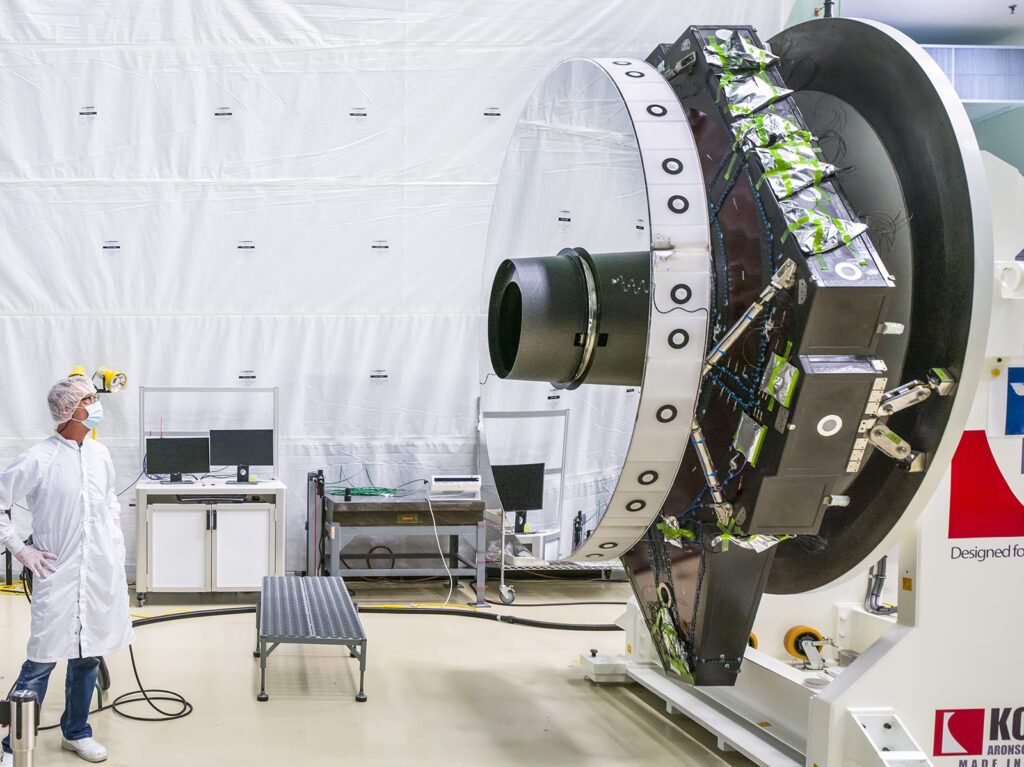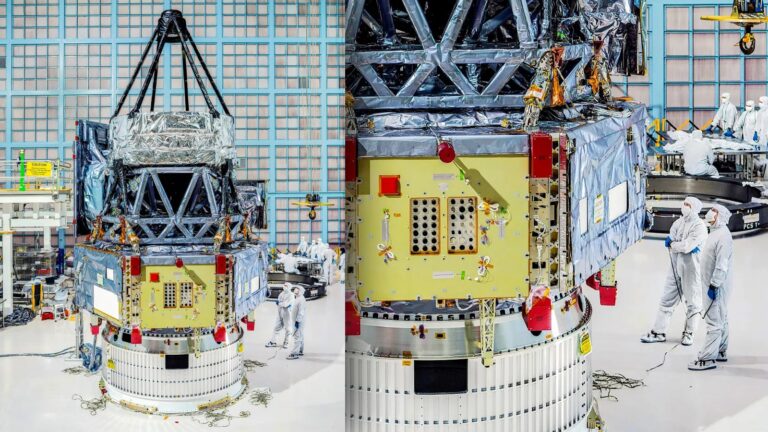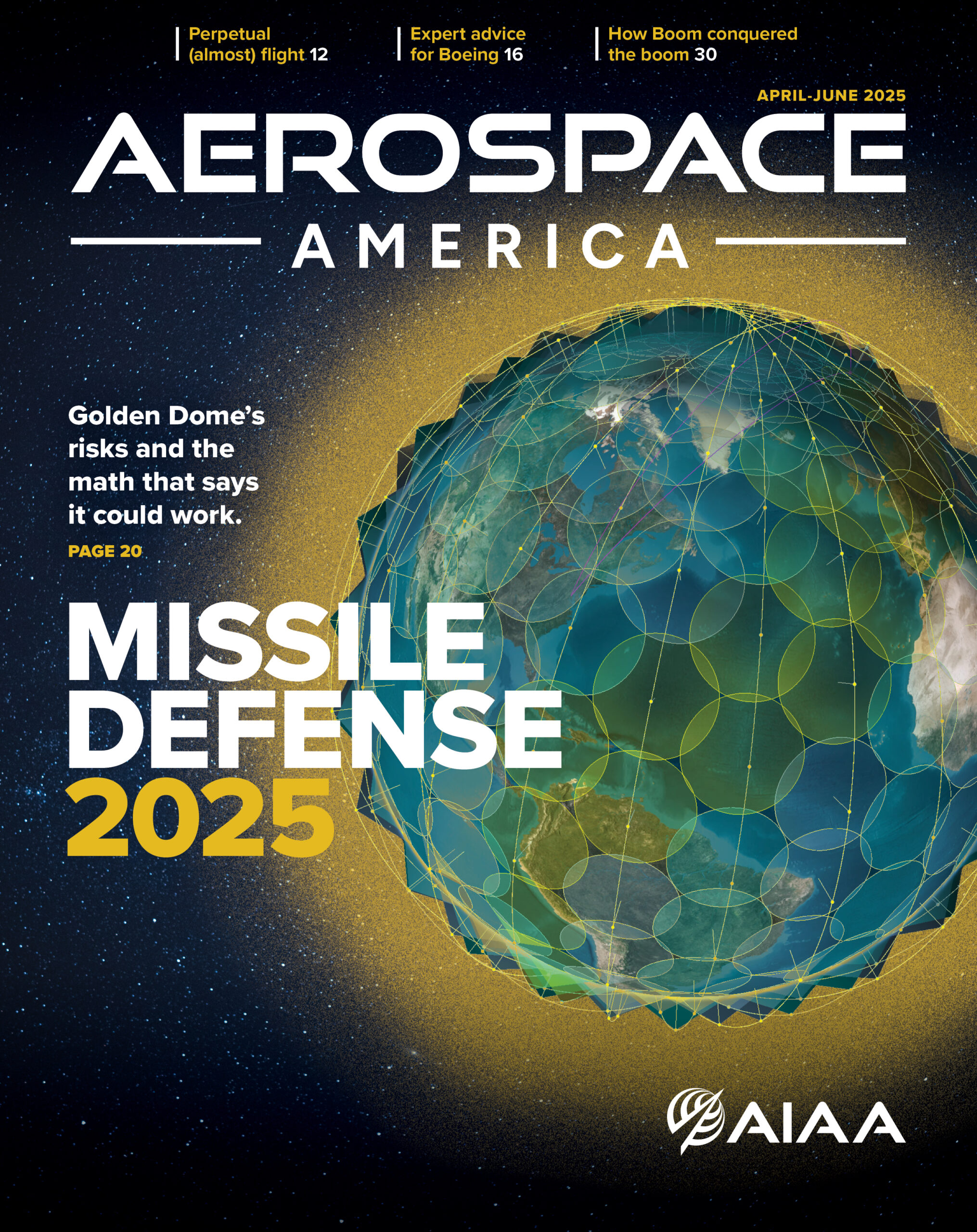Slung to the side of the Nancy Grace Roman Space Telescope will be a new kind of coronagraph that could take planet hunting to the next level, on top of its main mission of shedding light on the mystery of dark energy and dark matter. Jon Kelvey spoke to the scientists in charge.
At NASA’s Goddard Space Flight Center, a floor-length window provides a view of an eight-story clean room. It’s February, and I’m on the mezzanine watching bunny-suited technicians on a platform nicknamed a “surfboard.” Below them is a cylinder turned on its side, and the technicians are checking its solar panel mounts.
Their tasks, though essential to the success of this $4.3 billion future space telescope, are likely more straightforward than those required when the action half of the James Webb Space Telescope was assembled here. While this clean room is the largest of its kind in the United States, it still could not fit the fully assembled Webb. Its segmented mirror, other optics and instrument module were put together here and flown to Houston for more testing, and then sent on to California, where Northrop Grumman joined it to the other half and sent it off on a journey by barge through the Panama Canal to French Guiana for launch.
The cylinder in front of me is the outer barrel of the Nancy Grace Roman Space Telescope, or Roman for short. It will be nothing like Webb, although it is destined to be NASA’s next flagship space observatory. There will be no trip through the Panama Canal for Roman. Its primary mirror is a spare from a canceled spy satellite program, that measures 2.4 meters in diameter, compared to Webb’s 6.5. From the mezzanine, I can see the shape of that mirror, protected by a shroud. It crowns a column of optics, instruments, electronics and reaction wheels that will be set inside the outer barrel. Ultimately, Roman will be flown to Kennedy Space Center for a ride to orbit on a Falcon Heavy rocket in, optimistically speaking, October 2026. NASA has set a target of no later than May 2027.

Technologically speaking, Roman might seem like an underwhelming follow-up to Webb, but my interviews with astronomers and the leaders of this program suggest that would be a severe misjudgment. The biggest reason is a baby grand-piano-sized box of optics that’s among the hardware in the column of equipment. This is the Coronagraph Instrument, or CGI. Built at NASA’s Jet Propulsion Laboratory in California, it was installed last year onto the Roman instrument carrier. Light from the primary mirror will be reflected into the CGI, and it will follow a back and forth path consisting of 31 masks and mirrors whose role will be to block the light of a chosen star before it reaches the Exoplanetary Camera, or EXCAM. If this technique works as planned, planets a 100 million to a billion times fainter than their host stars should suddenly become visible.
While it would take a much larger mirror to catch the light from a planet the size of our own, Roman’s coronagraph is “ballpark about as good as it needs to be to be able to measure the reflected light from a nearby Earth-like planet,” says Dominic Benford, an astrophysicist and Roman’s top scientist, as technicians work in the clean room. “The coronagraph is possibly the most complex astronomical instrument that NASA has ever built,” says Benford.
So, while scientists don’t expect Roman’s CGI to reveal an Earth-like planet — the best that’s expected is a Jupiter-sized world — proving the technology in space could set it up for inclusion on a future space telescope that might be capable of doing so. That, says Benford, makes CGI a step toward one of the top goals identified by astronomers and astrophysicists in their 2021 decadal survey: “to discover worlds that could resemble Earth and answer the fundamental question: “‘Are we alone?’”
This coronagraph technology would not be bound for space in 2027 were it not for the mirror that was gifted to NASA in 2012. Initial design proposals for what’s now known as Roman assumed a smaller primary mirror, and the resulting spacecraft would not have been large enough to accommodate the coronagraph. The larger mirror and spacecraft created an opportunity to test the CGI technology in space for the first time, hence CGI’s designation as a technology demonstration.
Though it’s a demonstrator, exoplanet hunters have high hopes for the science it will produce, and CGI is my main reason for wanting to see Roman and meet with Benford and his colleagues. I’ll have other occasions to report on the telescope’s main mission, which is to help unravel the mystery of dark energy and dark matter.

“This is called a Lyot stop,” Neil Zimmerman, the lead Roman coronagraph scientist, tells me.
We’re standing at the back of the Goddard viewing mezzanine to escape the din of a group of visitors that just swept in. He pulled out his laptop and is showing me a schematic of an opaque disk followed by an opaque ring in the light path of a generic telescope. In 1930, French astronomer Bernard Lyot placed a disk at the right point in the light path of a telescope to block out the disk of the sun, not unlike what the moon does during a solar eclipse. He had created the world’s first coronagraph. But Lyot wasn’t finished. He realized that some amount of sunlight nevertheless passed around the edge of the disk — a diffraction ring — and that this could be further absorbed by a ring-shaped mask, yielding an even clearer view of the sun’s corona.
Roman’s CGI is a more elaborate version of Lyot’s coronagraph. What makes the Roman instrument experimental is the addition of two “deformable” mirrors, about twice the diameter of a U.S. quarter, that will receive the light near the start of the light path.
Here’s why they are needed: For an image to be clear and the spectra measurable, the coronagraph will need to control the light waves as they propogate through the instrument, sometimes ensuring they are aligned to increase the brightness, like two ocean waves cresting together into a single larger waver rolling onto the shoreline. At other times, the waves will be purposefully misaligned to create destructive interferance that eliminates unwanted starlight that has been diffracted around the masks.
The primary mirror will have subtle and shifting imperfections, changing shape slightly due to one side being slightly heated by the sun, so some form of correction is needed. The deformable mirrors and other filters will make those corrections. Each mirror assembly is backed by a grid of 48 by 48 actuators, constructed by Northrop Grumman out of layers of lead magnesium niobate. When high voltage from the spacecraft’s solar panel array is applied to them, an electric field is generated that causes the actuators to lengthen and deform the mirror surfaces. They will be commanded to make adjustments as large as 500 nanometers and as small as 7.5 picometers to the shape of the mirror.
Because the mirrors can be adjusted, they constitute “active” optics. Roman will be the first NASA spacecraft to fly an active coronagraph. Plans call for downloading initial images, analyzing them and then deforming the mirrors to obtain the clearest possible image of an exoplanet — about 100 times better than previous coronagraphs.
The goal is deceptively simple: View exoplanets by catching the same kind of light that makes Jupiter, Venus or Mars visible to us on a clear night.
“That is, light from the star that is reflected off the surface of the planet,” says Jason Rhodes, a Roman project scientist at JPL. By contrast, the Jupiter-sized exoplanets spotted by Webb with its passive coronagraph are “self-luminous — planets that are so hot they’re giving off their own light,” he explains.
These so-called “hot Jupiters” are relatively young. They orbit stars much larger than our own and at a much closer distance than the Jupiter in our solar system. The Roman coronagraph will attempt to take images and spectra of exoplanets much more like our Jupiter, a relatively cold gas giant orbiting much further out from its star.
“The Roman coronagraph represents our first opportunity to measure reflected starlight from a middle-aged Jupiter at a Jupiter sort of distance from a more sun-like star,” explains Nikole Lewis, a planetary scientist at Cornell University whose research focuses on gas giant exoplanet. “They’re really important for us to understand what other solar systems look like and if we are, in fact, really just very unique,” she says.
An exoplanet would show up as a point of light in the images rather than as full disks, like the photos of planets in our own solar system. But images aren’t all the coronagraph provides. Inside, the light remaining after filtering will also be directed through slits in a cylindrical spectrograph module. Inside this spectrograph, a prism will split the starlight into a spectrum of its constituent wavelengths. Elements and molecules of interest will produce characteristic breaks in the spectrum, black absorption lines corresponding to the frequencies of light that were absorbed by target elements and compounds rather than being reflected into space.

“The spectroscopy excites me the most, even though it will be a relatively simple mode for us,” says Zimmerman, Roman’s coronagraph lead. The team expects to be able to detect the spectral signatures of water vapor, oxygen and possibly methane, if they exist on the targeted planets. “I think there’s enough uncertainty about how planets like Jupiter and Saturn evolved that just measuring abundances will be very valuable.”
Astronomer Scott Gaudi of Ohio State University has studied just how much bigger a telescope would need to be to achieve the “Holy Grail” — images and spectroscopy of an rocky planet with liquid water and within the habitable zone of its star.
“Somewhere between 6 and 8 meters is probably the ideal,” he says.
Webb’s 6.5-meter-diameter primary mirror is about the right size, but without an active coronagraph to filter and delete starlight, Webb could not pick out an Earth twin in the glare of its star. Although an even larger, 12-meter-diameter mirror would be better, the cost and time constraints to build, launch and operate such a telescope make it an unlikely undertaking, cautions Gaudi.
NASA, however, already has a mission in mind that would meet the minimum size and resolution requirements. Plans call for the Habitable Worlds Observatory, currently targeted for launch sometime in the 2040s, to have a 6-meter-diameter primary mirror, segmented and folded for launch like Webb’s was. The larger mirror alone should give the Habitable Worlds coronagraph a 10 to 100 times improvement over Roman’s, according to Rhodes, and what scientists learn from Roman’s coronagraph could yield further improvements. In an inversion of Roman’s priorities, the primary mission of Habitable Worlds will be to find at least 25 potentially habitable exoplanets and analyze their atmospheric makeup.
Cosmology will take the back seat. “With the Habitable Worlds Observatory, the design goal is to have a capability of looking at 25 Earth-like planets,” says Rhodes, with the hope of pursuing “NASA’s big, overarching goal, which is to look for life elsewhere in the universe.”
Habitable Worlds will search for biomarkers on exoplanets, such as large, persistent quantities of methane and oxygen in a planet’s atmosphere that cannot be easily explained by nonbiological processes.
“We’re looking for gases that are out of equilibrium with what you expect without life having evolved there,” Zimmerman says, meaning only “extreme conditions” could produce similar footprints.
But even if Habitable Worlds detects clear signs of methane and oxygen on an Earth-like world, it won’t be considered sufficient evidence of life without further study, according to Gaudi.
“We’re not just going to get a spectrum and say, ‘Oh look, there’s life!’ We have to do it in context,” he says. Researchers will want to know the shape of the planet’s orbit, its temperature ranges, whether there are other planets in the star system and how much radiation the planet’s star emits. “What’s likely going to happen is we’re going to find something that’s tantalizing, suggestive, and then we’re going to build a bigger mission to study that planet even better.”

In addition to pioneering the active coronagraph technique, Roman will contribute by surveying 200 million stars in the Milky Way, with a goal of discovering somewhere between 60,000 and 200,000 exoplanets. Why such a large range? “The uncertainty is based on planet formation models, so how many we see is itself an interesting piece of information,” says Julie McEnery, an astrophysicist at NASA Goddard and the senior project scientist for Roman.
Lewis, the Cornell scientist, feels certain that Roman will yield discoveries about planet and solar system formation important to her work, and for capturing the attention of the public and ensuring support for future science missions. “Exoplanets have done nothing but challenge our imagination about what planets look like,” she says. “And people really connect with them. The kids especially really love it when I tell them about all these bizarre worlds where it’s raining glass.” She’s referring to discoveries made by Hubble, Webb and other telescopes, such as HD 189733 b, a Jupiter-sized world about 64 light years away whose clouds are laced with glass.
Operating the Roman coronagraph will also help Zimmerman and his team decide what improvements will be needed for the Habitable Worlds mission to maximize its odds of finding an Earth-like planet or planets. For one, during Roman they plan to experiment with the process for adjusting the optics, with an eye toward automating that process for the Habitable Worlds Observatory so that zones around stars can be examined more quickly. That telescope will need to adjust its coronagraph autonomously without back-and-forth downloading of images and uploading of instructions by a team of analysts on the ground.
“I think learning how to close that loop and do it efficiently is going to be the most valuable thing we get out of the Roman coronagraph,” Zimmerman says.
With Roman, scientists can also practice the types of studies they hope to do with Habitable Worlds, he adds. “So this is a stepping stone, yes. But it’s a really big stepping stone.”




